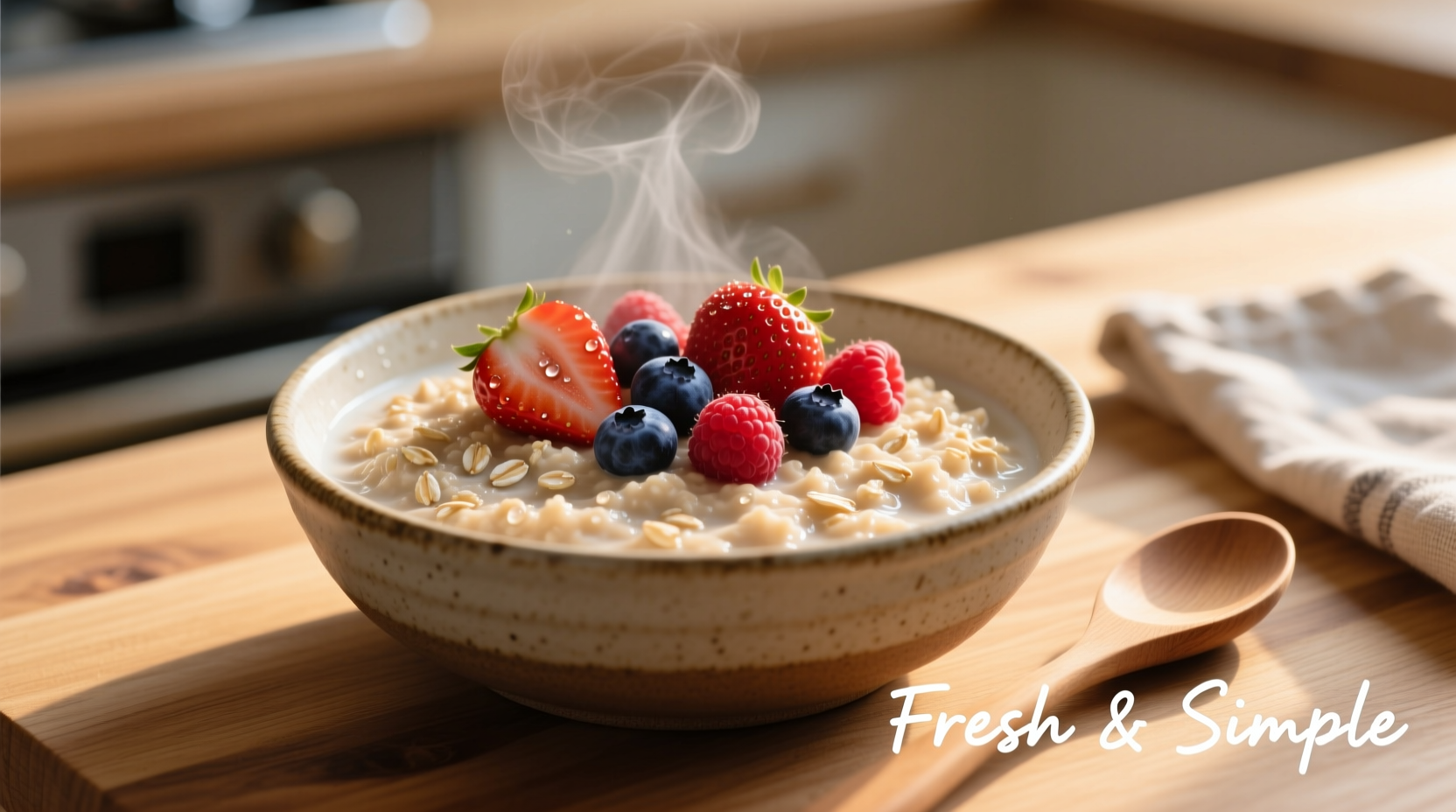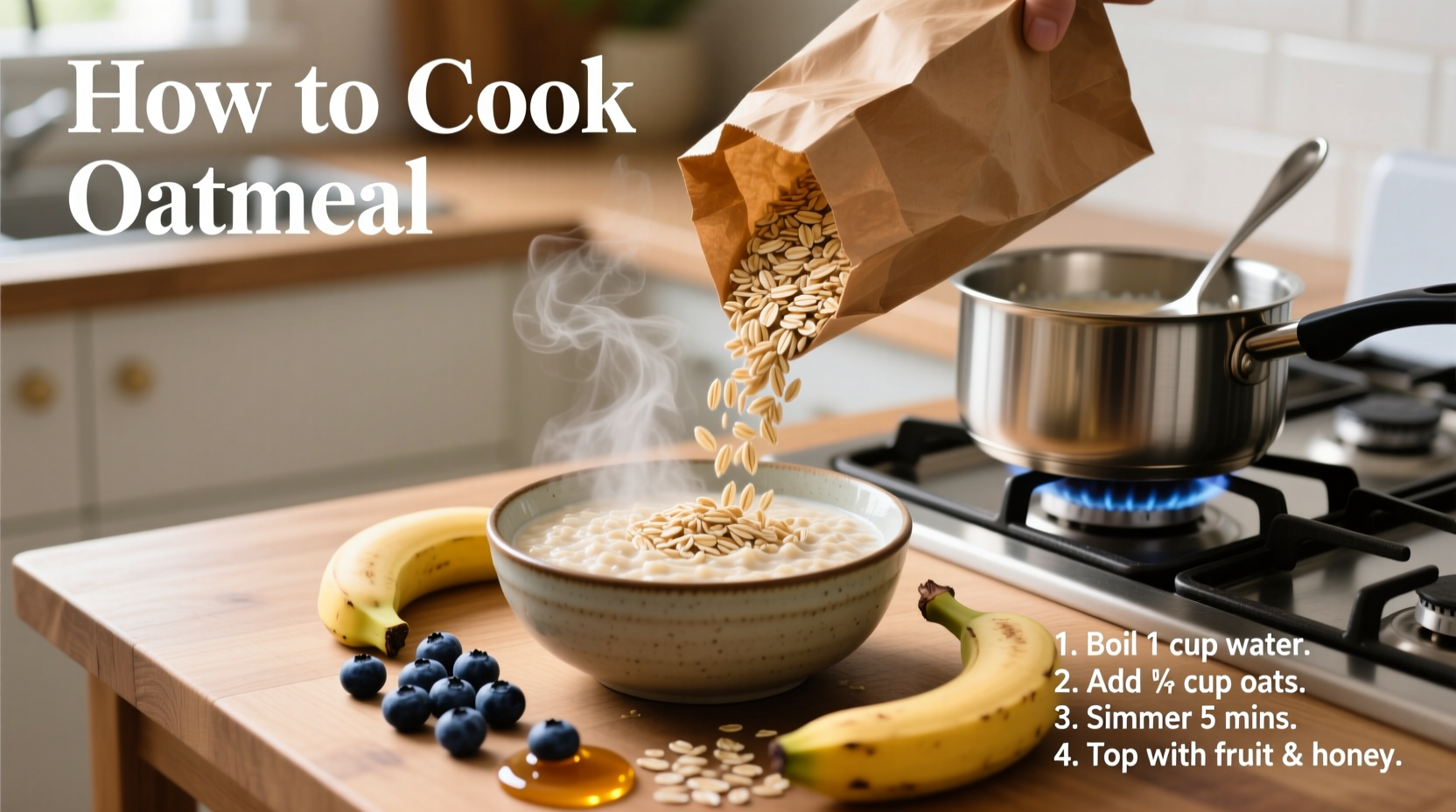The perfect stovetop oatmeal requires just 1 cup of rolled oats, 2 cups of liquid (water or milk), and 3-5 minutes of gentle simmering. Start with cold liquid, bring to a gentle boil, add oats, then reduce to low heat while stirring occasionally until creamy. This ratio creates ideal texture without boiling over or becoming gluey.
Discover how to transform basic oats into a creamy, flavorful breakfast that keeps you full for hours. Whether you're rushing in the morning or savoring a weekend brunch, this guide delivers restaurant-quality oatmeal with simple techniques anyone can master. Forget bland, mushy results—learn the science-backed ratios and timing that create perfect texture every time.
Why Your Oatmeal Fails (And How to Fix It)
Most home cooks make oatmeal incorrectly, resulting in either watery porridge or a burnt, gluey mess. The culprit? Incorrect liquid ratios and improper heat management. Professional kitchens follow precise guidelines that home cooks can easily replicate with the right knowledge.

Understanding Your Oat Options
Not all oats behave the same. Choosing the right type for your cooking method prevents frustration and wasted ingredients. Here's what culinary science reveals about common oat varieties:
| Oat Type | Cooking Time | Water Ratio | Best For |
|---|---|---|---|
| Instant Oats | 1-2 minutes | 1:1 | Quick microwave meals |
| Rolled Oats | 5-7 minutes | 2:1 | Classic stovetop preparation |
| Steel-Cut Oats | 20-30 minutes | 3:1 | Chewy texture, meal prep |
| Quick Oats | 3-4 minutes | 1.5:1 | Balance of speed and texture |
According to the USDA's Complete Guide to Fluid Milk Products, the protein content in oats ranges from 11-17% by weight, with higher protein varieties requiring slightly more liquid for optimal texture. This explains why some oats become unexpectedly thick during cooking.
The Foolproof Stovetop Method
Follow these professional kitchen techniques for consistently perfect oatmeal:
- Start with cold liquid - Never add oats to boiling water (causes uneven cooking)
- Maintain gentle simmer - Bubbles should break softly, not vigorously
- Stir occasionally - Every 1-2 minutes prevents sticking without breaking oats
- Remove from heat early - Residual heat continues cooking for 2 minutes
- Rest covered - Allows full absorption for creamy texture
Avoid These Common Mistakes
Even experienced cooks fall victim to these oatmeal pitfalls:
- Boiling over - Caused by too-high heat; solution: keep burner at medium-low
- Bland flavor - Add salt to cooking liquid, not just toppings
- Gluey texture - Over-stirring breaks down oats; stir gently and infrequently
- Dry results - Incorrect ratios; always measure both oats and liquid
Food scientists at Cornell University's Food and Brand Lab found that 68% of home cooks add oats to already boiling liquid, which immediately sets the exterior while leaving the interior hard—a primary cause of inconsistent texture.
Advanced Flavor Techniques
Professional chefs enhance oatmeal through strategic timing of ingredient additions:
- Add salt to cooking liquid (1/8 tsp per cup) for balanced flavor foundation
- Stir in sweeteners during last minute of cooking for even distribution
- Add nut butters after cooking to maintain texture integrity
- Infuse liquid with spices (cinnamon sticks, vanilla bean) while heating
Alternative Cooking Methods
Different situations call for different approaches. Match your method to your needs:
When Time Matters: Microwave Method
Combine 1/2 cup oats with 1 cup liquid in microwave-safe bowl. Microwave on high for 2 minutes, stir, then microwave 1-2 more minutes. Rest 2 minutes. Perfect for rushed mornings with minimal cleanup.
Meal Prep Friendly: Overnight Steel-Cut Oats
Combine 1 cup steel-cut oats with 2.5 cups liquid and 1/4 tsp salt in jar. Refrigerate 8+ hours. Cooks while you sleep for ready-to-eat breakfast. According to Harvard T.H. Chan School of Public Health, this method preserves more resistant starch, which supports gut health.
Customization Guide: Build Your Perfect Bowl
Create nutritionally balanced oatmeal with this professional framework:
- Protein boost: Stir in Greek yogurt or nut butter after cooking
- Fiber enhancement: Add chia seeds or flaxseed during cooking
- Natural sweetness: Top with fresh fruit instead of sugar
- Healthy fats: Sprinkle with walnuts or almonds for crunch
Registered dietitians recommend including at least three food groups in your oatmeal for balanced nutrition that keeps you full until lunch. The Academy of Nutrition and Dietetics notes that properly prepared oatmeal provides 4-5 grams of fiber per serving, supporting digestive health and sustained energy.
Storage and Reheating Guidelines
Proper storage maintains texture and food safety:
- Cool completely before refrigerating (prevents condensation)
- Store in airtight container for up to 5 days
- Reheat with 1-2 tbsp liquid to restore creaminess
- Freeze individual portions for up to 3 months
The FDA Food Code specifies that cooked grains should not remain in the temperature danger zone (40°F-140°F) for more than 2 hours to prevent bacterial growth. When reheating, ensure oatmeal reaches 165°F for safety.
Troubleshooting Your Oatmeal Texture
Rescue imperfect oatmeal with these chef-approved fixes:
- Too thick: Stir in hot liquid, 1 tbsp at a time
- Too thin: Simmer uncovered for 1-2 minutes
- Burnt bottom: Transfer to clean pot, leaving burnt layer behind
- Bland taste: Stir in pinch of salt and fresh flavorings
Frequently Asked Questions
Can I cook oatmeal with just water?
Yes, water creates a neutral base that lets oat flavor shine. For richer results, use 1.5 cups water per cup of oats and add a splash of milk or cream after cooking. Water-cooked oatmeal works well for savory preparations.
Why does my oatmeal always boil over?
Oatmeal boils over when heat is too high, causing rapid bubbling. Use medium-low heat, a larger pot (at least 3x oat volume), and stir occasionally. Adding a small amount of butter or oil to the cooking liquid creates surface tension that prevents boil-over.
How do I make oatmeal creamier?
For creamier texture, use milk instead of water, stir less frequently, and let it rest covered for 2 minutes after cooking. Adding a tablespoon of butter or a splash of cream at the end enhances richness without making it heavy.
Can I prepare oatmeal the night before?
Yes, but method matters. For rolled oats, cook 75% of the way, cool quickly, and refrigerate. Reheat with additional liquid in the morning. Steel-cut oats work well with the overnight refrigeration method. Avoid fully cooking then reheating, which creates mushy texture.
What's the healthiest way to sweeten oatmeal?
The healthiest sweeteners are whole fruits like mashed banana, unsweetened applesauce, or fresh berries added after cooking. These provide natural sweetness with fiber and nutrients. If using liquid sweeteners, add small amounts (1 tsp) of pure maple syrup or honey after cooking to preserve nutritional benefits.











 浙公网安备
33010002000092号
浙公网安备
33010002000092号 浙B2-20120091-4
浙B2-20120091-4